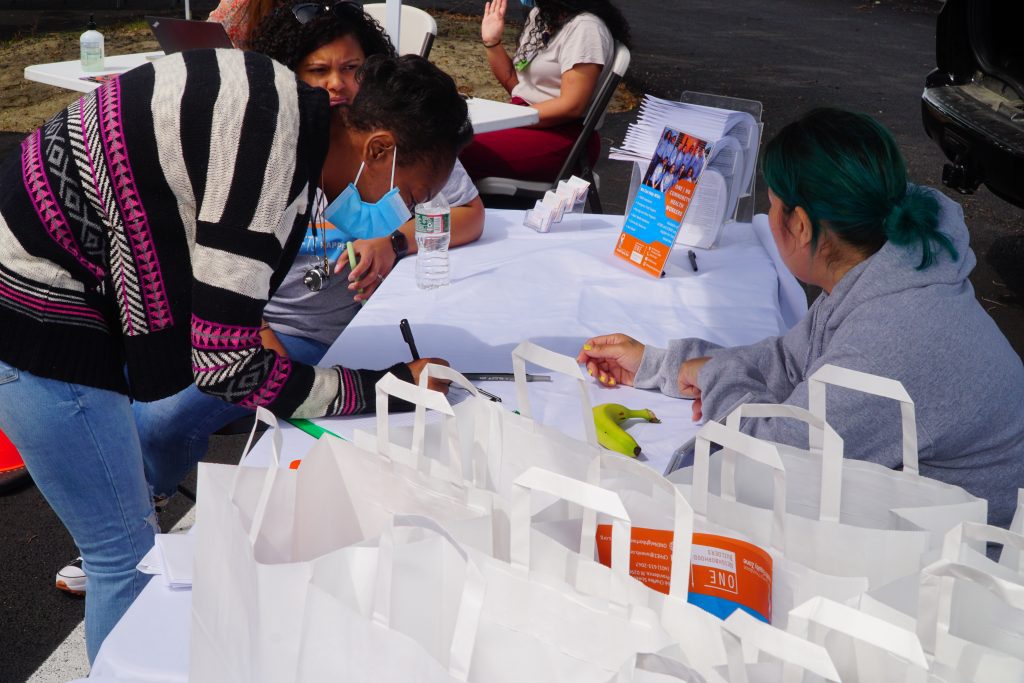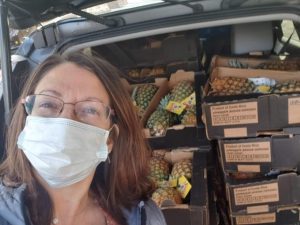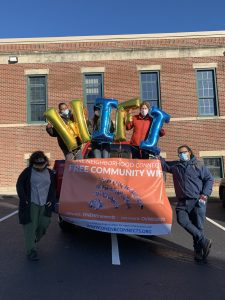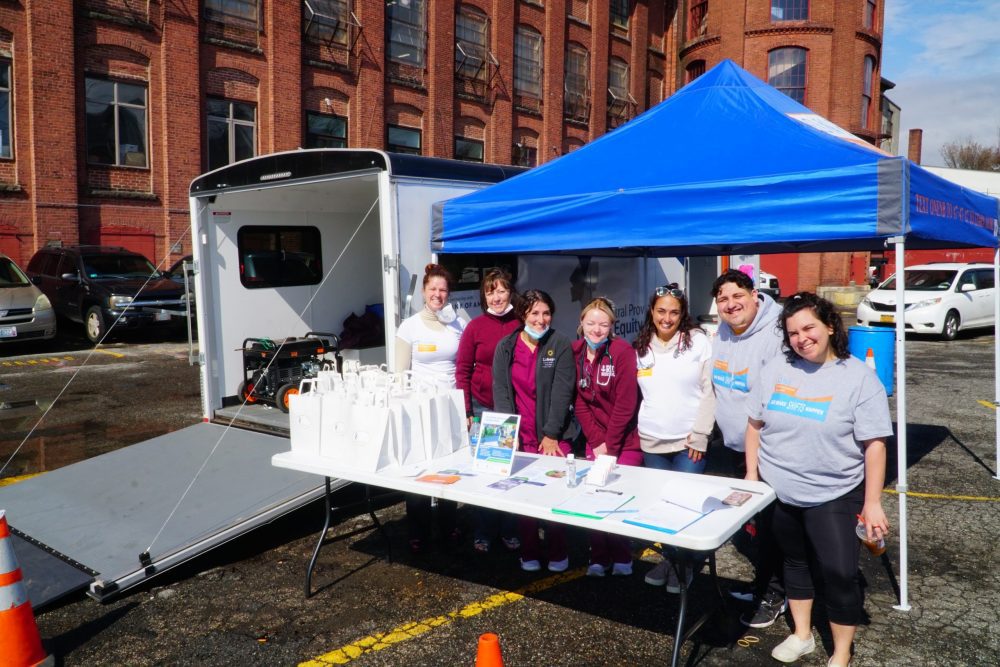
During the pandemic, a mobile health trailer staffed by health workers and staffers from ONE|NB offered residents of the Olneyville neighborhood of Providence information about rent relief, food assistance, help with paying their utilities, filing for health insurance, finding care for the uninsured, and other services. Photo by Stephen Ide, ONE|NB
Chris Kreymeyer is frustrated.
The president and CEO of Beyond Housing points to his window where, every day in this St. Louis neighborhood, he watches children walk to and from school. They’re low-income children, mostly Black, coming from families that often face multiple challenges.
The view is killing Kreymeyer. “I’m tired of seeing another generation of kids that won’t live up to their full potential,” he says.
Like other community development organizations around the country, Beyond Housing was deeply involved in food distribution and other emergency services during the thick of the pandemic. That was important work, he concedes, but it didn’t address the root inequities that have long existed and that COVID-19 lay bare.
Now that the pandemic finally seems to be ebbing, Kreymeyer is unwilling to go back to how things used to be. “If as a community writ large we feel good about [providing free food], then we’re missing the point. It’s like, ‘Is that all we got?’” he asks. “We have to do things differently.”
He’s not alone. As the pandemic wanes, or at least becomes woven into the fabric of regular life, many community development organizations around the country are experiencing something of an existential crisis.
Responding to the pandemic required everything they had, and it’s not over yet. Evictions, supply chain problems, residents’ mental health challenges, and burnout are all ongoing issues for organizations across the country. Those are valid and serious problems—and they will continue to be tackled.
But many leaders are, like Kreymeyer, deeply disturbed to see life going back to “normal.” During the pandemic, the community development field was vindicated and valued for its expertise and connections to low-income communities. The racial reckoning of 2020 brought public acknowledgment of deep-seated inequities and the importance of affordable housing. The vast inequalities that are a reality of 21st-century American life seemed to be finally on a path to changing.
Today, though, that transformation appears to have been short-lived. Little by little, the nation seems to be drifting away from those realizations and inching back to its same old, same old: a country lacking the interest and fortitude to take on longtime problems.
For community development organizations, the question is how to move forward. Many are now more aware than ever of all they could be doing for vulnerable individuals and families, but they can’t do it alone. Can they bring funders, policy makers, and the public along when the appetite for structural change seems to be disappearing?
Some Organizations Are Still in Crisis Mode
Of course, though restrictions and the sense of panic may have lifted, the pandemic isn’t actually over. And not everyone working in community development has the time to ponder big-picture questions. In some communities, residents remain in a state of emergency, and organizations there are still operating in crisis mode.
Brooklyn-based Fifth Avenue Committee is one of them. “The number of evictions filed for has gone up exponentially since the moratorium ended,” says Michelle de la Uz, executive director. New York City had a rent moratorium and offered emergency rental assistance for a while. While those measures provided significant protections to tenants, they effectively kicked the eviction can down the road. Renters may have been able to remain in their homes, but some may now owe large sums equal to months’ worth of rent.
“The moratorium had the unintended consequence of creating really significant arrears that some people will never be able to get out of. If you’re a poor person digging out of that hole, that’s really challenging,” says de la Uz.

Michelle de la Uz, Fifth Avenue Committee’s executive director, with the many pineapples donated for their COVID-19 food distribution. Photo courtesy of Michelle de la Uz, Fifth Avenue Committee
Her organization is now doing everything it can to help residents who are in trouble. Just applying for emergency rental assistance—even if there’s no funding left—gives tenants some protections, and Fifth Avenue Committee’s tenant organizers have had their hands full helping people apply. The group is also assisting tenants who are fighting eviction in court, because there’s a shortage of attorneys who can represent them.
“It’s not over, especially for communities and the people who serve them,” says de la Uz of the pandemic. She speaks with the urgency and fatigue of a sergeant in battle. “There’s a tsunami in displacement and homelessness that’s going to happen if more rental assistance isn’t allocated quickly.”
At the same time, the organization itself is a landlord, owning and managing 480 units. With tenants continuing to struggle, the organization is too. Its rental arrears rate has doubled and vacancies are taking longer to fill. “We’ve never had to deal with helping this many people before as a landlord,” says de la Uz. “The image I have is of a snake trying to swallow an elephant. It’s going to take years to get back to what it was like before.”
New York isn’t the only region where tenants are in trouble. But in many other areas, assistance only recently ran out, and legal protections are still in place. In response, some community development leaders are holding their breath in expectation of “the cliff”: ballooning eviction numbers in the next few months once the guardrails are gone.
Evictions aren’t the only daunting problem. In some places, residents simply can’t catch their breath, financially speaking. “We’re just caught in this terrible whirlwind of disasters,” says Kathy Payton, president of Houston’s Fifth Ward Community Redevelopment Corporation. The community experienced high infection and death rates during the pandemic, and the region’s COVID-19 rates are spiking again. Meanwhile, prices are way up due to inflation, and hurricane season is about to begin—even though some residents haven’t fully recovered from the city’s 2021 winter storm.
The organization is so busy putting out fires and helping people with basic needs, its staff can’t begin to address long-term objectives. “I just read that egg prices went up 22 percent, and chicken is up 16 percent,” says Payton. “How do you even encourage healthier eating when people are just trying to survive?”
Finding a Way to Plan for the Future
Some groups, though, were able to carve out space even during the fog of the pandemic to develop bigger-picture initiatives that feel aligned with their long-term missions.
For example, with homeowners stuck inside for months, interest in emergency home repair grants swelled in many places. In Warren, Ohio, when the city’s waiting list filled up, Trumbull Neighborhood Partnership wound up getting involved. Eventually, the group found state and foundation funding to scale up the work.
“Emergency” or not, providing home repair grants feels aligned with the group’s overarching objectives, says Matt Martin, the organization’s executive director. “It keeps people in their homes, which is good for the community—it’s homeownership preservation.” That work will be a priority in the future, says Martin.

Staffers from ONE|NB spell out WiFi in balloons at a parade they held when the network launched, the day after Thanksgiving, 2020. Photo courtesy of ONE|NB
Similarly, One Neighborhood Builders in Providence, Rhode Island, launched a free community wireless network early in the pandemic for neighborhood residents who otherwise wouldn’t have had internet access. The project was started in the spirit of a short-term emergency, but the organization is committed to maintaining it for five years—hoping that after that, a wider broadband effort will make their work obsolete.
In Burlington, Vermont, Champlain Housing Trust became part of the city’s COVID-19 response for homeless people. The organization already had experience purchasing motels and converting them into homes for housing-insecure people, and quickly set about buying several more that could serve as quarantine spaces for homeless people with COVID.
“We bought seven motels during that time,” says executive director Michael Monte. Gradually, as the need for quarantine spaces dissipates, Champlain Housing Trust will use the units in other ways: for refugees, as rental housing, for victims of domestic violence, and as longer-term supportive units for homeless people.
Many community development organizations have also continued to develop affordable housing. Or at least, they’ve tried.
Some have been very successful in moving projects along. In Seattle, for example, Community Roots Housing (formerly Capitol Hill Housing) is having a banner year; it has 1,100 units in the pipeline for the next five years.
But most have not. First of all, inflation and supply chain issues have driven construction prices way, way up. “For affordable housing, bids are coming in 20 or 25 percent higher,” says Joe Kriesberg, president of the Massachusetts Association of CDCs. Simultaneously, he says, labor shortages have hit a range of key industries. “It’s really hard to get contractors—they’re super busy. Plumbers are super busy.”
But government staffing shortages are arguably the biggest problem. In Boston, the city must approve an affirmative fair housing marketing plan before affordable housing projects can move forward. During the pandemic, the department lost two key staff members and approvals that normally require a few weeks were taking up to a year. (The mayor’s Office of Housing reports that those positions have now been filled and approvals should once again occur quickly.)
In New York City, a shortage in government attorneys, building inspectors, and Department of Homeless Services employees has radically delayed the development of much-needed permanent housing.
And in Syracuse, the organization Home HeadQuarters can’t utilize properties from the city’s land bank the way it normally does because the city government’s collection of tax seizures came to a halt. But prioritizing new construction means figuring out how to cover the cost of newly expensive building materials.
The demand is there, says Karen Schroeder, Home HeadQuarters’ chief communications officer, “but it’s hard to make the numbers work.”
Refocusing on People and Their Mental Health
Many groups have also begun to think about how to better serve low-income communities and individuals in ways that aren’t about programs and projects. It’s clear that everyone is burned out—certainly many community development employees, whose frenzied pace and sense of urgency have only recently dissipated, as well as the people they work with.
“Everyone’s carrying a little baggage right now: employees, customers, city workers, construction guys. Everyone’s a little frayed at the edges,” says Schroeder. “We try to keep in mind that everyone’s going through something.”
It’s particularly true for the residents they work with. In response, organizations are realizing they need to prioritize resident services and increase person-to-person contact in a way that flexibly meets people where they are. For some groups, that might mean asking residents more frequently about potential rent shortfalls that may be on their horizon and letting them know about available resources. For others, it’s about responding more organically to what clients actually need from a home, rather than rigidly promoting homeownership.
[RELATED ARTICLE: Helping Tenants with Mental Health Challenges Who Are at Risk of Eviction]
But some organizations say that at heart, the shift is about being more aware of how residents are doing and feeling, and responding to that.
“The pandemic and lockdowns and loss of work only exacerbated any mental health issue that anyone was grappling with,” says Chris Persons, CEO of Community Roots Housing. “There’s not enough support for resident services that we can then use to support folks. If I was going to point to one thing that the pandemic demonstrated, it’s the weakness of that.”
Earlier in the pandemic, his organization was able to procure funding from the Seattle City Council to pay for services for residents, and he’s hoping it’ll remain in the budget this year. Ultimately, he’d like to have enough to be able to call in mental health professionals when it’s clear that residents are in the midst of a crisis.
Takao Suzuki, director of community development at Little Tokyo Service Center in Los Angeles, has also observed that residents of all ages seem to have more behavioral health challenges than before the pandemic. In response, the organization is planning to step up its interactions with the people it serves.
“We need to have a lot more touch points with people who live in our buildings,” says Suzuki. Little Tokyo offers a variety of services, from parenting support groups to health visits for seniors, and its recreation center, which reopened last year, is popular with all ages. The goal, he says, is to ensure that the employees staffing the facilities are trained to pay attention and respond if someone is acting in a way that’s concerning.
“I think the pandemic has made that even more evident—that these support networks are really, really critical in our daily lives,” says Suzuki. “Moving forward, we need to empower folks not just financially but also in terms of their capacity to be more sustainable and resilient to these volatile things like COVID and policy changes.”
What Comes Next?
Despite burnout on all sides, and ongoing, multifaceted challenges, it’s evident in conversation with community development leaders that many of them feel pretty good right now. It’s not just that their organizations were uniquely able to help stabilize their communities. It’s also that the groups were finally seen and valued for their expertise. They were needed.
Some of that was subtle. For example, Champlain Housing Trust was able to buy more motels only because local government officials acknowledged their track record and created funding pathways specifically for them. In other cases, groups were asked to help get public health funding or American Rescue Plan dollars out the door, or to spread the word about COVID prevention and testing options.
“It was probably one of the first times the county immediately reached out to us,” says Pilar Hogan Closkey, executive director of Saint Joseph’s Carpenter Society in Camden, New Jersey. “They said something like, ‘I know you guys are on the ground; can you help us?’”
Elizabeth Celaya, Hudson River Housing’s director of strategic initiatives, reports a similar experience with local government officials in New York. “People would look to us and say, ‘You’re the housing folks. What are the needs? How should we use those funds?’”
On a wider scale, though, the pandemic, the national dialogue that ensued after George Floyd was killed, and a growing public awareness of the U.S.’s affordable housing crisis put a spotlight on inequities that community development organizations have been contending with for decades. For many groups, that kind of public interest is very new.
“It keeps coming up: this new attention on racial and social justice issues and the role of housing within that,” says Celaya. “That’s been a huge transformational shift.” Her organization is now being asked to give advice and opinions, even on topics it’s not involved in, and local residents and policymakers are becoming more engaged with the group’s work.
“It’s been a new landscape for us to navigate. It makes us want to be open and connected to the community in new ways,” she explains. “We haven’t fully fleshed out our role.”
Other organizations are grappling with a similar issue. The past two years illustrated their importance. Where do they go from here?
To Kriesberg, president of the Massachusetts Association of CDCs, it’s obvious: “This is a chance to finally make some progress on deep-seated disparities. We’ve built relationships; now’s not the time to retreat.” He and his colleagues are already advocating at the state level for a continuation of funding targeted to low-income residents.
But others say what’s needed is not just more funding but a focus on deeper structural change. For some groups, that might not come naturally. “It’s not a tangible widget,” says Jennifer Hawkins, executive director of Providence’s One Neighborhood Builders “The bigger structure or system that leads to these [problems] in the first place is much more amorphous and long-term, and I think that’s where we need to spend our time and energy.”
Malcolm Yeung, president of Chinatown CDC in San Francisco, agrees. Community development groups were able to pivot and work in unfamiliar fields—food distribution, distance learning, public health—because they had earned residents’ trust. That trust grew out of relationships built through community organizing. And that’s where Yeung thinks groups should return their attention.
“The key isn’t housing or economic development programs or technical assistance: it’s some form of organizing, some investment in deep relationships,” he says. Those connections will pave the way for the development of infrastructure to support the communities’ needs.
But Yeung argues that the field must simultaneously address weaknesses that arose or became apparent as a result of COVID. For example, frontline staff working with people who suffered during the worst months of the pandemic are still struggling; they need to be helped and reengaged before organizations can thrive again.
Yeung and many others in the field are concerned that the nation is so eager to go “back to normal” that Americans are willfully forgetting many of the lessons learned over the past two years. “I think there’s an urgency to leave COVID-era impacts behind and pretend that we can just reset with a clean slate,” says Yeung.
Payton in Houston feels similarly. Conversations about racism, inequality, and police brutality are no longer as prominent as they were two years ago, even though little has fundamentally changed. “I think if people don’t talk about it, they think it’ll go away.”
Does that mean community development organizations’ moment is slipping away?
If so, Kreymeyer, in St. Louis, is determined to make the most of it before it’s gone. His group recently launched a major fundraising campaign. It includes events with some of the city’s big stakeholders and a media buy in St. Louis’s business journal that’s resulting in advertising, editorials, and articles about investing in lower-income neighborhoods. Kreymeyer is determined to finally get the kind of funding his community needs in order to improve its kids’ prospects.
“We’re swinging for the fences here,” he says.






National NeighborWorks Association, as the trade association representing NeighborWorks organizations (including Beyond Housing, Champlain Housing Trust, Fifth Ward Community Redevelopment, Home HeadQuarters, Hudson River Housing, ONE Neighborhood Builders (mentioned in this article) and 231 other NeighborWorks organizations applaud Shelterforce and Ms. Abrams for this spot on article.
We cannot go back to normal as an industry; treading water (though doing it well) in the face of community and economic need. The pandemic confirmed that our members will do what needs to be done not just on a “normal” basis, but in the face of a national crisis. Things need to change – policy, funding, access, equity and so much more for community and societal growth and stability.
Thank you for the article.
Good article
A great overview of the challenges facing organizations addressing seemingly intractable problems of housing shortages, homelessness, structural inequality, and personal mental wellness. As we used to say long ago – “Keep on keeping on.” Thank each one of you for the tireless efforts.